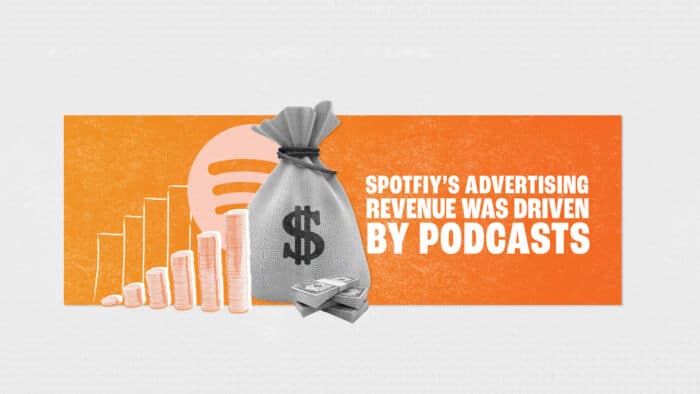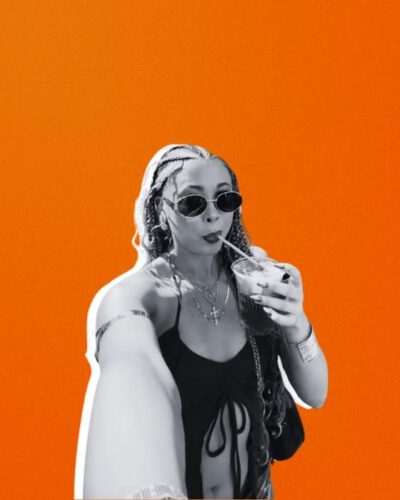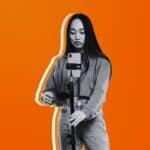It’s no secret by now that audio content is having a moment! Globally, listening rates to audio content have increased with people wanting to connect due to heightened feelings of loneliness and isolation.

In 2021, Spotify reported that 72% of Millennials in the UK viewed podcasts as a mental health resource, and in that year alone the audio platform saw an increase of 113% among Millennials and a 175% increase among Gen Z listeners (Spotify 2021) – and that’s just data from the UK!
Audio formats such as podcasts present an opportunity for brands, with 81% of listeners acting on an ad, as a result of hearing a podcast advertisement (Spotify 2021). But why is audio content so powerful? Well, podcast hosts bridge the gap between brands and listeners by creating audio that feels personal and intimate, building a bond through frequent episodic content.
The Audio Connection On Social Media
Social media platforms have been quick to invest and roll out audio-only features following the meteoric success of Clubhouse during the pandemic. Clubhouse has seen a huge jump in users since its inception, with significant growth occurring between 1st February and 16th February 2021, when the app gained over 4.6 million users (Think Impact, 2021). Why? Well, the platform delivered a fresh experience of audio-only content, where users could join rooms and listen to a diverse range of conversations.
Audio-only rooms feel personal and the ability for users to jump in and actively participate in conversations creates an interactive experience that is unique and exciting. However, the platform has since seen its growth gradually slow due to competitor platforms quickly rolling out features replicating the experience on Clubhouse!
Enter Twitter with its audio-only feature named Spaces. Twitter quickly saw an opportunity with audio content on the platform and unlike Clubhouse, Twitter had a large pre-existing userbase that it could test this feature with. Twitter was quick to test and optimize the audio feature on the platform, rolling out new offerings as quickly as Clubhouse to replicate the user experience.
Twitter recently stated that Spaces is driving growth on the platform and as a result, Twitter is investing very regular feature updates to provide hosts with greater controls and exposure on the platform. Most recently, Twitter rolled out the ability for app hosts of Spaces to record audio conversations – allowing creators to turn such content into podcasts or repurpose on other social platforms!
Platforms such as Facebook are also moving in on audio. Facebook is quickly developing their in-app podcast offerings, allowing users to distribute their podcast shows through the platform – expanding the audience reach.
How Spotify Took Over The Podcast Market

Then we have Spotify, which over the last 2 years has seen significant growth across listener rates – much in part due to podcasts. Spotify is very much a data-driven platform shown in the Spotify Wrapped campaigns, that package all the data it gathers on users into a fun and interactive in-app event that creates huge spikes in social conversations.
So it’s no surprise that Spotify recognized a consumer shift with audio-only and podcasts. As reported by Spotify, there was an increase in users listening to audio content through connected home-based devices including desktop computers (+35%), gaming consoles (+52%), smart speakers (+59%), and TVs (+55%).
What we’ve seen from Spotify in the past couple of years is a huge investment in podcasts, with the platform acquiring podcast technologies and companies, as well as securing huge talent deals. Examples of Spotify’s exclusive podcast deals include the likes of Joe Rogan, Olivia O’Neil, Rickey Thompson and Denzel Dion, and TikTok dancer Addison Rae and Lele Pons. The platform has been leveraging influencer talent to get ahead of competitors and utilising a creator’s existing audience to attract new users to the platform.
The platform has also invested in building out personalized podcast discovery experiences for users to aid podcast reach and potential, among many other audio-focused offerings. The CFO of Spotify has stated that the streaming platform will be investing $3.5 billion into podcast and audiobook expansions. It was stated by Spotify that in their Q3 2021, $370 of advertising revenue was driven by podcasts, which is an overall 75% year-on-year growth from Q3 2020.
How Podcasts Can Aid In Specific Audience Segmentation
Nowadays there is a podcast for everything! Whether that be a US podcast dedicated to the latest K-Pop releases to the history of the plastic straw – basically if you can think of it there’s probably a podcast out there. This means advertisers have the ability to reach niche audiences and align products with interests, attitudes and beliefs, which are discussed in a specific podcast.
For example, if you’re a beauty brand that produces Korean skincare and looking to launch the product in the US market, you could target the podcast that discusses the latest K-Pop releases – as clearly this podcast is followed by those who have an interest in the culture.
Podcasts also allow advertisers to leverage the credibility cultivated through episodic content between the listener and host. In the same way, YouTuber’s have a huge influence on their audience through regular long-form content, podcast hosts are able to build deep connections with listeners because both listener and hosts have shared interests or beliefs. this can be a powerful advertising tool for marketers who can leverage the trust of a host among their audience.
How Branded Content Is Executed Through Podcasts
Ad integrations can be tailored, dependent on the goal, audience target and podcast theme. Marketers typically utilise ad reads (both live or pre recorded) which are delivered by the podcast host who will be guided by a pre-approved script that will cover an overview of the brand, product or service USPs and any incentive deals. These ad integrations can be done before, during or after the podcast concludes.
Some of the most effective ad reads allows creators to integrate their own personality, personal stories and experiences in the advertisement to ensure the ad is delivered authentically. Podcast hosts that simply read word by word of a script can come across as disingenuous, so brands will want to avoid being too prescriptive.
Case Study: The Receipts Podcast
The Receipts Podcast is hosted by three women in London, who have honest and open conversations about dating, relationships, race, culture, and personal life experiences. The podcast has gained 100,000+ listeners on Spotify in over 71 countries. The podcast is essentially known for raw, and honest conversations, which have successfully connected with thousands of people globally.
As a result of the success of the podcast among audiences, the three hosts have secured an exclusivity deal with Spotify. Some recent sponsors who have aligned with the Receipts Podcasts include the NHS and WhatsApp. In both promotions, a pre-recorded ad read was utilised. The WhatsApp ad read, for example, had the hosts promote encrypted messages between senders and recipients. The hosts delivered the ad read in a manner that intertwined personal experiences and aligned with their values and beliefs, which was far more persuasive when delivered to listeners over a traditional radio ad – which is often delivered by a voice actor and rarely tailored to a specific audience.
Case Study: Native
Another great case study that explores how brands can approach podcast partnerships from a data-led perspective is Native. Native is a natural deodorant that utilised podcasts as an additional marketing channel, with the aim of reaching more of its target audience.
The brand essentially looked at the data to find out what interest groups would align with their product offering and where they were consuming content online. After conducting research and analyzing the data, the brand expanded out to interest groups beyond health and wellness to areas such as art, fitness and tech.
This information, along with listening demographics and behavior, allowed the brand to strategically target interest groups through specific podcasts. Using audience insights, the brand tailored ad promotions on podcasts such as “Armchair Expert With Dax Shepard”, in order to raise awareness among new audience segments and leverage the connection of a podcast host and viewer to deliver authentic promotions.
Brands Launching Dedicated Podcasts
Brand podcasts are also having a minute – with huge players, such as Walmart, launching podcasts to directly speak to consumers through episodic content that is more personal and engaging than a post on Instagram. Brand podcasts aren’t always hosted by brand representatives – we are seeing a huge trend of influencers being utilised as hosts or as guests.
A great example of this is The Pretty Little Thing ‘Behind Closed Doors’ podcast – which is available through audio streaming platforms and YouTube. The podcast uses a host to interview various influencers in a casual, ‘girl talk’ type interview, allowing the brand to leverage an influencer’s audience to discuss relevant topics that resonate in order to build brand affinity. The host typically interviews influential figures in PLT clothing, but the content isn’t pushing the product, the brand sees the value of delivering relatable content to keep the brand in front of the mind of consumers.
The brand has also explored livestream podcasting, which is done through the PLT Instagram channel. The live sessions, named ‘Press Pause’ allows users to consume episodes of the podcast, in a similar ‘girl chat’ format to the Behind Closed Doors series – but live. This allows users to interact and discuss topics in real time with the host and influencer.
Overall, Pretty Little Thing has successfully leveraged influencers who represent and define their audience and interests – blurring the lines and boundaries between host and listener. The brand is an example of how powerful it can be to embrace influencers as a part of the brand identity and maximize engagement. This podcast marketing approach uses a more candid content strategy to help the brand become a part of the consumer’s lifestyle, beyond their products.
Where Does Audio Stand In 2022
Audio formats are presenting significant opportunities for both brands and platforms, whether that be with platform growth, user engagement or effective brand promotions. We’ve seen podcasts explode in popularity, with listeners having the ability to find niche topics and communities of like-minded individuals.
As a result, brands have the ability to tap into specific audience segments, to put products in front of consumers who have very specific interests. Couple this with the strong bond podcast hosts can cultivate with their audience, a brand can leverage such connections for authentic promotions that drive interest and potential sales.
Moving into 2022, we will see more brands experiment with launching brand podcasts for content marketing and partner with creators on existing podcasts to reach new audiences or build brand affinity. However, as we fast forward to the future where we will see the development of the metaverse – there will certainly be a place for communities to gather for conversations, much like Clubhouse found with audio-only rooms during the pandemic.
The opportunities are certainly endless as technology develops and people find new ways to connect with others online.




